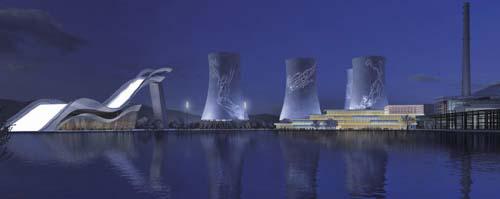Olympic Feats
By Yuan Yuan


Dubbed the Ice Ribbon, the skating venue for the 2022 Winter Olympic Games in Beijing (Beijing 2022) won praise from the International Skating Union (ISU) on May 27, though it is still under construction. As the only new permanent structure being built specifically for the Games in Beijings downtown, it is expected to be completed by the end of 2019.
Featuring 22 separate light strands fl owing up and around the oval, with a distinctive and poetic facade, the National Speed Skating Oval (NSSO) can accommodate 12,000 spectators, including 6,800 permanent and 5,200 temporary seats. The design is fl exible so as to enable it to stage long- and short-track speed skating, fi gure skating, ice hockey and curling competitions.
In the lead up to and during Beijing 2022, the NSSO, which began construction in April 2017, will be the home of Olympic training and competition for speed skating events. After the Games, the 31.6-meter- high gymnasium will open for public ice sporting events.
“Im sure the athletes will be very fascinated with and happy to be welcomed by such a venue in 2022,” Vice President of ISU, Tron Espeli, said. “Its very encouraging to see coexistence between speed skating and other ice sports and public use in the ovals post-Olympic utilization plan.”
Speeding things up
The construction on Beijing 2022 venues will be accelerated this year, according to a plan released by organizers on May 31. Co-hosted by Beijing and Zhangjiakou in Hebei Province, the competitions will be split between the two cities, or three clusters, to be more accurate: the Beijing downtown cluster, the Yanqing cluster in Beijings northwestern suburban district of Yanqing and the Zhangjiakou cluster.
According to the layout plans for 2022 Winter Olympic venues unveiled by Beijing on February 20, 2014, five ice events will be held in Beijings downtown cluster while the luge, bobsleigh and alpine skiing events will be held in the Xiaohaituo Mountain area in the Yanqing cluster, 90 km from Beijings city center. All other skiing events will be held in Chongli County, Zhangjiakou, 220 km from downtown Beijing and 130 km from the Xiaohaituo Mountain area.
Among the 26 venues for the Games, 18 are located in Beijing, including both competitive and non-competitive sites. Of them, fi ve new venues are set to be completed by June 2020, with eight renovated venues to be completed by 2021.
With ample snow in the winter and high-altitude mountains, Yanqing is ideal for the luge, bobsleigh and alpine skiing events. The design of the Xiaohaituo Alpine Skiing Field features an athletics track and training trails that resemble several white waterfalls fl owing down the valley from the top of Xiaohaituo Mountain. It can accommodate more than 8,000 spectators.
“The Xiaohaituo Mountain in Yanqing is one of the few mountains in China that meets the standards of an Olympic venue in terms of its height,” said Gao Xuedong, Deputy Secretary General of the Chinese Ski Association.
Gao explained that in China, the height of mountains at about 85 percent of the countrys ski resorts is below 200 meters. But according to International Ski Federation standards, the height of a mountain for official downhill events must be at least 800 meters. Xiaohaituo Mountain meets this requirement at 2,198 meters high.

However, the fact that the mountain is tall and steep has actually made logistics particularly challenging. “The construction of the Xiaohaituo Alpine Skiing Field may be one of the toughest tasks of the preparations for Beijing 2022,” said Zhang Jie, an executive manager from the Beijing Urban Construction Group Co. Ltd., the project constructor. Since all the large construction machines couldnt be operated on the narrow and steep hill paths, the company had to dig a new path to deliver materials.
The Xiaohaituo Bobsleigh, Skeleton and Luge Track is currently under construction and, along with the skiing fi eld, will be the site of 20 Olympic events.
New sustainable games
The issue of sustainability was discussed at a debriefing of the Beijing Organizing Committee for the 2022 Olympic and Paralympic Winter Games on June 5 in the Shougang Industrial Park in west Beijings Shijingshan District, which used to be a steel mill but has now been transformed into the headquarters of the committee.
The budget for Beijing 2022 has been set at $3.5 billion. As the fi rst city in the world to host both a summer and winter Olympics, Beijing will renovate many of the venues used in the 2008 Summer Olympics for the upcoming Winter Olympics. For example, 11 of the 13 ice sports venues in downtown Beijing are from the 2008 Summer Olympics, such as the Wukesong Sports Center which will be used for ice hockey and the National Aquatics Center, commonly known as Water Cube, for curling.
President of the International Olympic Committee (IOC) Thomas Bach said the reuse of existing venues as well as costeffective support from the IOC will help Beijing 2022 set a new benchmark for future Olympics. Beijing has also pledged that all the venues built for 2022, especially those for snow events, will incorporate plans for public use after the Games.
Since it won the bid to host the 2022 Winter Olympics, China has encouraged funds from various sources to get involved in the construction of venues for the Games. The NSSO, for example, involved funding, resources and operational expertise from multiple private businesses to share the costs and diversify future operational plans.
“It will be an effective model for encouraging the private sector to offer innovative and commercially practical solutions for the sustainable use of the venue,” said Wang Gang, an offi cial from Beijings governmental offi ce overseeing the project.

